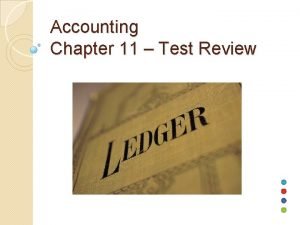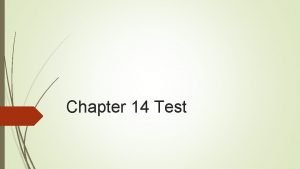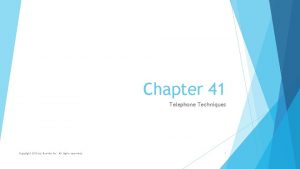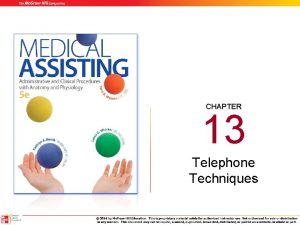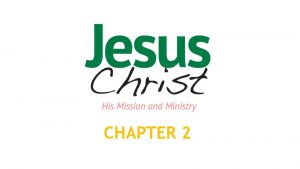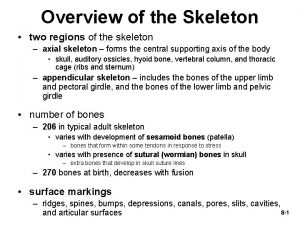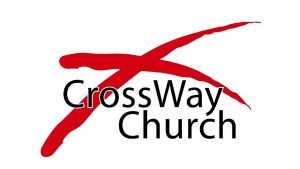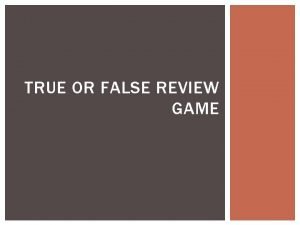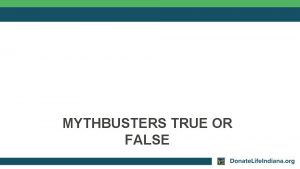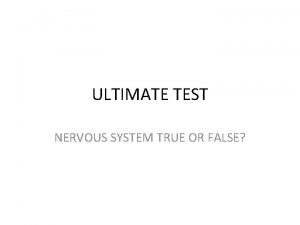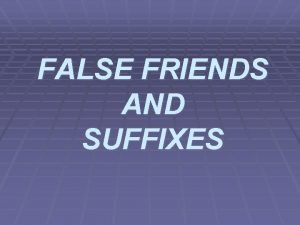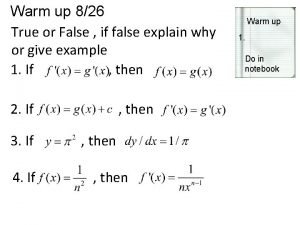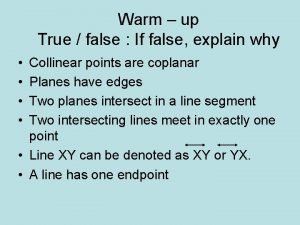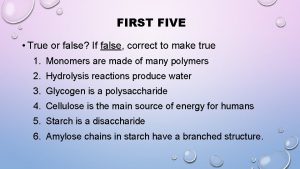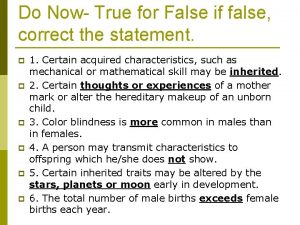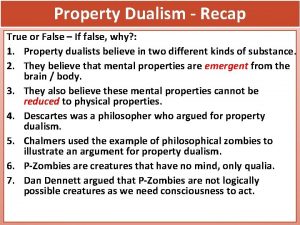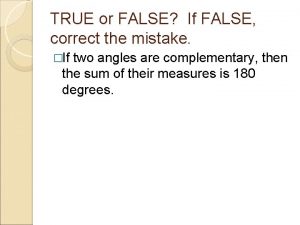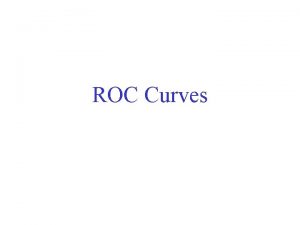Chapter 14 Test True or False 1 and



















- Slides: 19

Chapter 14 Test

True or False #1 and #7 The allowance method of accounting for uncollectible accounts does not comply with generally accepted accounting principles. FALSE Allowance method is the only method allowed by GAAP

#2 and #12 When a customer account is written off under the allowance method, the book value of accounts receivable decreases. FALSE Book value = Gross AR – Allowance for Uncollectible accounts

#3 and 16 A note provides a business with legal evidence of a debt in the event it becomes necessary to go to court to collect TRUE

#4 and 10 Total assets are reduced when a business accepts a note receivable from a customer needing an extension of time to pay an account receivable FALSE The asset class is changed from an Accounts Receivable to a Notes Receivable

#5 and #11 The book value of accounts receivable must be a reasonable and unbiased estimate of the money the business expects to collect in the future. TRUE

#6 and #1 The accounting concept Neutrality is applied when the process of making accounting estimates is free from bias. TRUE

#7 and #2 The expense of an uncollectible account should be recorded in the accounting period that the account becomes uncollectible. FALSE The reason for doing the allowance method for uncollectible accounts is to try to match revenue with expenses. The expense is estimated and matched with the revenue in the same period the revenue was earned.

#8 and 18 The account Allowance for Uncollectible Accounts has a natural credit balance. TRUE It is a contra asset account. An asset account has a natural debit balance; therefore, this account would have a credit balance

#9 and #8 A business usually knows at the end of the fiscal year which customer accounts will become uncollectible. FALSE If the business had a crystal ball that would tell them this information, they wouldn’t have extended credit to those customers to start with

#10 and #9 The account Allowance for Uncollectible Accounts is reported on the income statement. FALSE This is a contra asset account which is reported on the Balance Sheet

#11 and 3 The percent of each age group of an accounts receivable aging that is expected to become uncollectible is determined by generally accepted accounting principles. FALSE It is determined by historical data

#12 and #4 The adjusting entry for uncollectible accounts reduces the balance of the Accounts Receivable account. FALSE The Accounts Receivable balance stays the same. The adjustment is made as a debit (increasing) to the Uncollectible Accounts Expense and a credit (increase) to Allowance for Uncollectible Accounts (contra asset)

#13 and #5 A business having a $400. 00 debit balance in Allowance for Uncollectible Accounts and estimating its uncollectible accounts using accounts receivable aging to be $5, 000 would record a $5, 400 credit to Allowance for Uncollectible Accounts TRUE The account is a normal credit balance; it currently has a debit balance of $400. $5, 000 + $400 would be $5, 400.

#14 and #6 Interest rates are stated as a percentage of the principal. TRUE

#15 and #17 Interest income is classified as revenue from normal operations FALSE It is classified as other income.

#16 and #13 When using the allowance method, writing off an uncollectible account does not change the net realizable value of account receivable. TRUE Net realizable value = Gross Accounts Receivable – Allowance for Uncollectible Accounts. Just a reclassification of the account.

#17 and #14 The direct write off method complies with Generally Accepted Accounting Principles FALSE The only method that is GAAP approved is the allowance method

#18 and #15 The direct write-off method matches the expense of uncollectible accounts to the revenue that is earned in the same period. FALSE This is why it is not GAAP approved. The direct writeoff method records the expense only after the account has been determined to be uncollectible. This could be weeks after the revenue has already been recorded.
 Amer rasheed
Amer rasheed Accounting chapter 11 true false
Accounting chapter 11 true false Accounting chapter 14 true and false
Accounting chapter 14 true and false Sign chapter 37
Sign chapter 37 Chapter 41 telephone techniques critical thinking
Chapter 41 telephone techniques critical thinking Define a routing list as it pertains to incoming calls
Define a routing list as it pertains to incoming calls Chapter 3 true or false
Chapter 3 true or false Chapter 2 jesus christ true god and true man
Chapter 2 jesus christ true god and true man True/false
True/false Sound waves are mechanical waves true or false
Sound waves are mechanical waves true or false False and true vocal cords
False and true vocal cords Difference between true ribs and false ribs
Difference between true ribs and false ribs True or false: chemical and physical changes alter matter.
True or false: chemical and physical changes alter matter. 3/128 as a percentage
3/128 as a percentage True or false an isosceles triangle can be scalene
True or false an isosceles triangle can be scalene True and false questions about smoking
True and false questions about smoking Read the sentences and decide if they are
Read the sentences and decide if they are True and false disciples meaning
True and false disciples meaning Read the sentences and decide if they are true or false
Read the sentences and decide if they are true or false Memory stages model
Memory stages model

